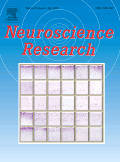
Journal of Neurophysiology
Scope & Guideline
Connecting research to the heartbeat of neural science.
Introduction
Aims and Scopes
- Neural Mechanisms of Behavior:
Research focusing on the neurophysiological underpinnings of various behaviors, including motor control, sensory processing, and cognitive functions. - Electrophysiology and Neural Recording:
Studies employing advanced electrophysiological techniques to investigate neural activity in different contexts, such as during movement, sensory stimulation, or learning. - Neuroplasticity and Learning:
Investigations into how neural circuits adapt and change in response to experience, including studies on motor learning, rehabilitation, and the effects of training. - Pathophysiology of Neurological Disorders:
Research examining the neurophysiological changes associated with various neurological conditions, including Parkinson's disease, stroke, and neurodegenerative diseases. - Integration of Multisensory Information:
Exploration of how the brain integrates information from different sensory modalities to inform perception and action. - Neural Circuitry and Connectivity:
Studies that analyze the structural and functional connectivity within neural circuits, using techniques like imaging and tracing to map out pathways and interactions.
Trending and Emerging
- Neurotechnology and Brain-Machine Interfaces:
There is an increasing focus on the development and application of neurotechnologies, including brain-computer interfaces and neural prosthetics, to restore or enhance neural function. - Machine Learning in Neurophysiology:
The integration of machine learning techniques for analyzing neurophysiological data is on the rise, allowing for more sophisticated modeling of neural responses and behaviors. - Transcranial Magnetic Stimulation (TMS) and Non-Invasive Brain Stimulation:
Research utilizing TMS and other non-invasive stimulation techniques to explore causal relationships in neural circuits and their implications for cognitive and motor functions is gaining traction. - Neuroinflammation and Its Impact on Neural Function:
Emerging studies are increasingly investigating the role of neuroinflammation in various neurological disorders, focusing on its effects on synaptic function and plasticity. - Interdisciplinary Approaches to Neurophysiology:
There is a trend toward interdisciplinary research that combines neurophysiology with fields such as psychology, robotics, and computational modeling to address complex questions about brain function.
Declining or Waning
- Basic Sensory Processing:
There has been a noticeable reduction in studies centered around basic sensory processing mechanisms, possibly as researchers focus on more complex integrative functions or applied neuroscience. - Animal Models in Neurophysiology:
Fewer studies are using traditional animal models for basic neurophysiological research, as there is a growing emphasis on human studies and clinical applications. - Pharmacological Interventions:
Research focusing solely on pharmacological interventions for neurological conditions has decreased, with a shift toward exploring non-pharmacological approaches such as neurostimulation and behavioral therapies.
Similar Journals

Neural Development
Advancing the Frontiers of Developmental NeuroscienceNeural Development, published by BMC, is a premier open access journal dedicated to advancing the field of Developmental Neuroscience. Established in 2006, this journal continues to foster high-caliber research on the cellular and molecular mechanisms underlying neural development, contributing significantly to our understanding of brain structure and function. With a commendable Q1 ranking in the 2023 category of Developmental Neuroscience and a notable position as the 8th out of 37 journals in the field on Scopus, it is recognized for its rigorous peer-review process and impactful publications. Researchers, professionals, and students benefit from the widespread accessibility of its content in an evolving landscape of neuroscience studies. As an open-access journal, Neural Development ensures that groundbreaking discoveries are available to a global audience, facilitating collaboration and innovation in the exploration of neural mechanisms. With its strong commitment to quality and relevance, this journal remains at the forefront of developmental neuroscience research.

NEUROPHYSIOLOGY
Pioneering Discoveries in Neuroscience and PhysiologyNEUROPHYSIOLOGY, published by SPRINGER, is a distinguished journal dedicated to advancing the understanding of neural function and physiological processes across a broad spectrum of topics. With a rich history dating back to 1969, this journal has been instrumental in disseminating pivotal research findings and theoretical advancements within the fields of neuroscience and physiology. Although it currently ranks in the fourth quartile of both the Neuroscience (miscellaneous) and Physiology categories, this journal remains a valuable resource for researchers and professionals seeking to explore innovative methodologies and address critical issues within neurophysiological studies. While NEUROPHYSIOLOGY does not offer open access options, its latest research continues to provide insights and stimulate discussions essential for education and ongoing inquiry. Publishers and contributors to this journal contribute to a growing repository of knowledge right from the heart of the United States.

CEREBRAL CORTEX
Pioneering research in cognitive and molecular neuroscience.CEREBRAL CORTEX, published by Oxford University Press Inc, is a premier journal dedicated to advancing the field of neuroscience, specifically focusing on the cellular, molecular, and cognitive aspects of cortical structure and function. With an impressive impact factor that situates it in the top quartile (Q1) of its categories for 2023, this journal holds significant relevance for researchers and professionals interested in the latest discoveries and methodologies in both Cognitive Neuroscience (ranked #31 out of 115) and Cellular and Molecular Neuroscience (ranked #48 out of 97). Operating without an open access model, it ensures rigorous peer review and dissemination of high-quality research from across the globe. Since its inception in 1991, CEREBRAL CORTEX has established itself as a critical platform for educators and inventors, pushing the boundaries of knowledge in understanding brain function and its implications for behavior. Researchers and students alike will find this journal an invaluable resource for both foundational and cutting-edge studies in neuroscience.

Eneurobiologia
Bridging Research and Application in NeurobiologyEneurobiologia is an esteemed open-access journal published by UNIV VERACRUZANA, INST INVESTIGACIONES & EDUCACION, dedicated to advancing research in the vibrant field of neurobiology. With its launch in 2010, the journal aims to disseminate high-quality, peer-reviewed research articles that explore the complexities of neural systems, neurodevelopment, and neurodegenerative disorders. By providing a platform for both established researchers and emerging scholars, Eneurobiologia fosters interdisciplinary collaboration and knowledge exchange within the scientific community. Its open-access model ensures that valuable findings are accessible to a global audience, promoting the widespread application of neurobiological research. As a crucial resource for students, professionals, and researchers alike, Eneurobiologia plays a pivotal role in shaping the future of neurobiological studies and enhancing our understanding of the brain and nervous system.

NATURE NEUROSCIENCE
Elevating Neuroscience Through Rigorous ScholarshipNATURE NEUROSCIENCE is a premier journal published by NATURE PORTFOLIO, focusing on cutting-edge research in the field of neuroscience. With an esteemed impact factor that reflects its significance in the academic community, this journal occupies an exceptional place in the 2023 Q1 category for neuroscience (miscellaneous) and boasts a leading Scopus rank of #1 out of 113 in general neuroscience, placing it within the top 1st percentile. Since its inception in 1998, NATURE NEUROSCIENCE has consistently delivered high-quality, peer-reviewed articles that contribute to our understanding of the nervous system, driving innovation and scholarship across disciplines. Although it does not offer open access, the journal remains a vital resource for researchers, professionals, and students seeking to stay at the forefront of neuroscientific discovery and discussion. Its editorial commitment to excellence ensures that it continually shapes the trajectory of neuroscience research well into 2024 and beyond, making it an indispensable asset for anyone passionate about the brain and its complexities.

NEUROSCIENCE RESEARCH
Elevating Understanding in the Neuroscience LandscapeNEUROSCIENCE RESEARCH, published by Elsevier Ireland Ltd, is a leading journal in the field of neuroscience, with a notable reputation for disseminating high-quality research that spans a variety of topics within the discipline. With an ISSN of 0168-0102 and an E-ISSN of 1872-8111, this journal serves as a vital platform for both established researchers and emerging voices in the field. Ranking in the Q2 quartile in both Medicine and Neuroscience categories, it has been recognized as a reliable source of innovative findings since its inception in 1984, with continuous publication through 2024. Although it does not currently offer Open Access options, the journal is indexed in Scopus, holding a significant position at Rank #48/113 in General Neuroscience, reflecting its contribution to advancing the understanding of neural mechanisms across various contexts. With its address anchored in Ireland, NEUROSCIENCE RESEARCH plays an essential role in bridging scientific inquiry and practical applications, making it an indispensable resource for researchers, professionals, and students dedicated to the burgeoning field of neuroscience.

NEUROSCIENTIST
Exploring New Dimensions in Neuroscience ResearchNEUROSCIENTIST is a leading journal in the field of clinical neurology and neuroscience, published by SAGE Publications Inc. With an impressive impact factor reflected in its Q1 quartile ranking in both clinical neurology and miscellaneous neuroscience as of 2023, this journal positions itself as a crucial platform for the latest research and advancements in the neural sciences. Spanning from 1995 to 2024, NEUROSCIENTIST features a range of high-quality, peer-reviewed articles that cater to researchers, practitioners, and students alike. Although it does not offer Open Access options, the journal remains a vital resource owing to its Scopus rankings, situating it within the top percentile of its categories: ranked #28 out of 400 in clinical neurology and #15 out of 113 in general neuroscience. The journal's commitment to disseminating significant findings underlines its importance in fostering advancements in neurological understanding and treatment.

NEUROBIOLOGY OF LEARNING AND MEMORY
Transforming Insights into Learning and Memory NeuroscienceNeurobiology of Learning and Memory is a prestigious journal dedicated to the exploration of the neural mechanisms underlying learning and memory processes. Published by Academic Press Inc Elsevier Science, this journal boasts a strong reputation within the field, as evidenced by its impressive impact factor and high quartile rankings in multiple categories, including Q1 in Behavioral Neuroscience and Q2 in Cognitive Neuroscience. Having provided a platform for groundbreaking research since its inception in 1995, the journal aims to disseminate influential findings that further our understanding of cognitive processes, shaped by robust empirical studies and theoretical developments. Researchers and professionals in neuroscience, psychology, and related disciplines will find invaluable insights and advancements that underscore the journal's commitment to fostering knowledge and innovation within these fields. While it currently operates under a subscription model, its comprehensive coverage of crucial topics positions it as a vital resource for those engaged in the intricate study of learning and memory.

Annals of Neurosciences
Empowering Interdisciplinary Approaches in NeuroscienceAnnals of Neurosciences, published by SAGE Publications Ltd, is a distinguished journal that serves the vibrant field of neuroscience. With an ISSN of 0972-7531 and E-ISSN 0976-3260, it has been a significant platform for advancing knowledge in various aspects of neuroscience since its inception. The journal, positioned in the Q3 category in the realm of neurosciences (miscellaneous) as of 2023, aims to bridge the gap between basic research and clinical practices, providing a comprehensive forum for the dissemination of innovative research, reviews, and insights within the field. With a convergence period from 2011 to 2024, it continually emphasizes the importance of interdisciplinary approaches in understanding neural mechanisms and their implications for mental health and neurological disorders. The journal's open access options ensure that research findings are widely available, fostering collaboration and dialogue among researchers, professionals, and students globally. Located in London, England, the Annals of Neurosciences stands out as an essential publication for those aiming to stay at the forefront of neuroscience research and application.

Annual Review of Neuroscience
Exploring Breakthroughs in Neuroscience ResearchThe Annual Review of Neuroscience, published by Annual Reviews, is a premier journal that has been at the forefront of neuroscience research since its inception in 1978. With an ISSN of 0147-006X and E-ISSN 1545-4126, this leading academic journal boasts a remarkable impact factor, placing it in the prestigious Q1 category in Neuroscience (miscellaneous), with an impressive Scopus ranking of 4 out of 113 and a stellar 96th percentile in general neuroscience. Focused on publishing comprehensive and authoritative review articles, the Annual Review of Neuroscience aims to synthesize and critically evaluate the latest advances in the field, making it an indispensable resource for researchers, professionals, and students alike. While it does not offer open access, the insights and discoveries highlighted in its issues are crucial for those dedicated to understanding the complexities of the nervous system and driving forward innovative research. With a commitment to excellence and a forward-looking perspective, this journal continues to shape and influence the future of neuroscience.